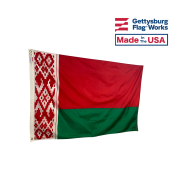Flag of Belarus

The Flag of Belarus
Belarusian flags are among the youngest in the world. Their modern design, which is a bicolor of red and green with an ornamental design along the staff, only received government approval in 2012. That government approval came more than a decade after the design was first developed and approved by the citizenry through a referendum in 1995.
The current national flag of Belarus was formally adopted on June 7, 1995, following the result of a referendum voted on by the Belarusian people in the previous month. This new design replaced a historical flag used by the Belarusian People's Republic of 1918, before Belarus became a Soviet Republic, and again after it regained its independence in 1991. The current flag is a modification of the 1951 flag used while the country was a republic of the Soviet Union. Several flags used by government officials and agencies were based on the national flag.
A few groups have continued to use the white and red flag, though its display in Belarus has been restricted by the government of Belarus allegedly due to its association with Nazi collaboration during the Second World War. That flag is used in protests against the government and by certain groups of the Belarusian diaspora.
- Capital of Belarus: Minsk
- Area of Belarus: 207,600 sq. km
- Languages used in Belarus: Belarusian, Russian
- Religions in Belarus: Eastern Orthodox, Roman Catholic, Protestant, Jewish, Muslim
Symbolism of Belarusian Flags
Unlike many governments, Belarus has not legally defined the symbolism of Belarus flags. President Alexander Lukashenko did give an informal explanation of the flag's symbolism. He explained that the red section of Belarusian flags represents both freedom and the sacrifices made by previous generations, while the green section represents life. The flag's decorative pattern is a traditional design, so it serves to represent that traditional values and culture of the nation's people. The colors originated while the nation had a communist government, and that government assigned a different symbolic value to them. The red was said to represent that blood that had been shed during the communist revolution, while the green represented the beautiful forests of Belarus.
History of Belarus Flags
There have been several historical Belarus flags. Like many nations, it used a red flag with gold text while it was led by a communist government. The red flag eventually gave way to a more unique design in 1951. The 1951 design forms the basis for the modern flag. Unlike the modern flag, it had a golden hammer and sickle in the canton that represented the working classes, and the outline of a gold star above that emblem. The communist flag had an ornamental design along the staff like the modern flag, but the design was different.
The nation used a white and red flag between 1991 and 1995. The Belarus flag's design dated back to at least 1918, and it had been used by many groups in Belarus since it was first developed. The white and red flag fell out of use after a referendum in which a majority of citizens voted in favor of the modern flag.





